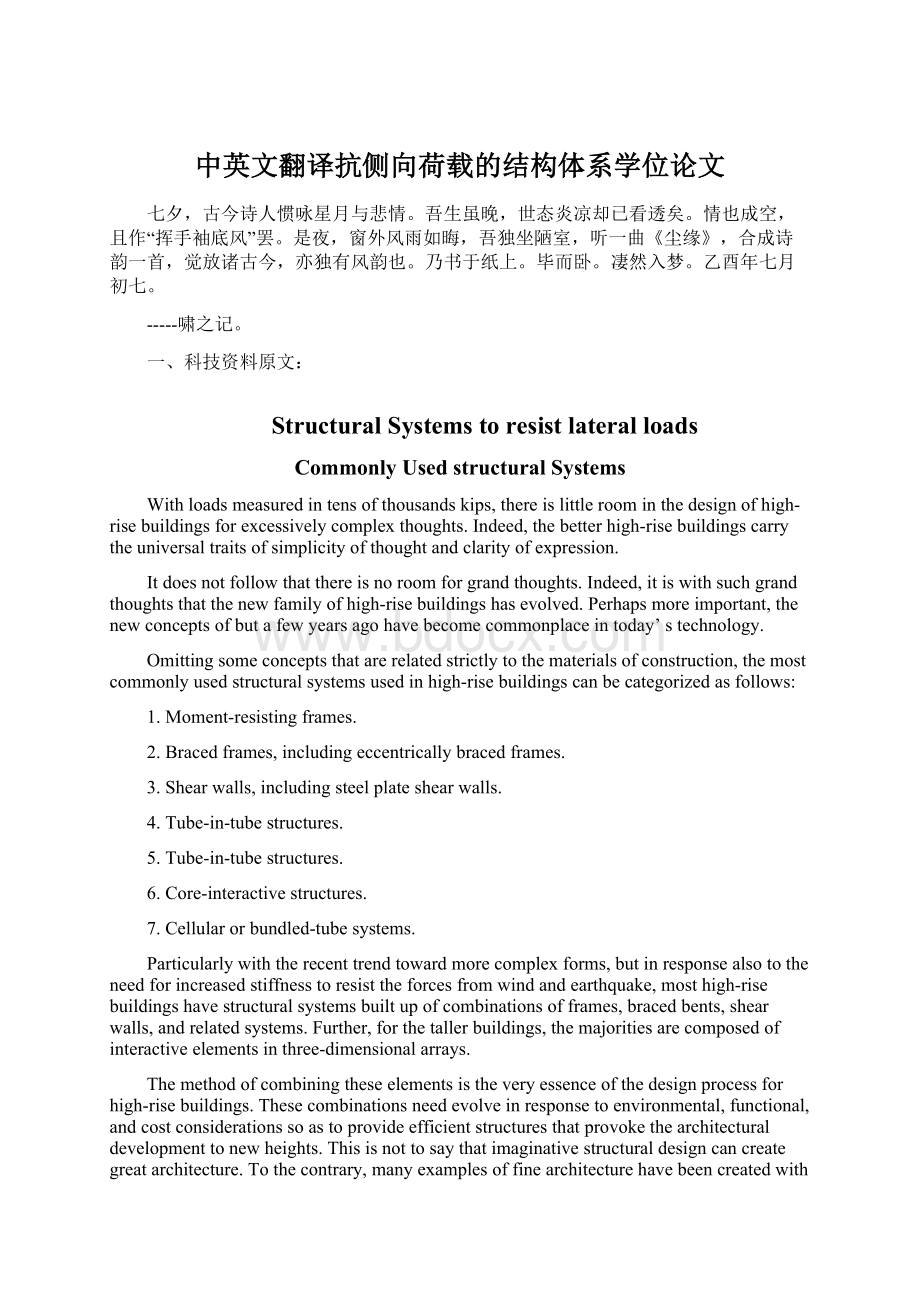中英文翻译抗侧向荷载的结构体系学位论文Word下载.docx
《中英文翻译抗侧向荷载的结构体系学位论文Word下载.docx》由会员分享,可在线阅读,更多相关《中英文翻译抗侧向荷载的结构体系学位论文Word下载.docx(9页珍藏版)》请在冰豆网上搜索。

乃书于纸上。
毕而卧。
凄然入梦。
乙酉年七月初七。
-----啸之记。
一、科技资料原文:
StructuralSystemstoresistlateralloads
CommonlyUsedstructuralSystems
Withloadsmeasuredintensofthousandskips,thereislittleroominthedesignofhigh-risebuildingsforexcessivelycomplexthoughts.Indeed,thebetterhigh-risebuildingscarrytheuniversaltraitsofsimplicityofthoughtandclarityofexpression.
Itdoesnotfollowthatthereisnoroomforgrandthoughts.Indeed,itiswithsuchgrandthoughtsthatthenewfamilyofhigh-risebuildingshasevolved.Perhapsmoreimportant,thenewconceptsofbutafewyearsagohavebecomecommonplaceintoday’stechnology.
Omittingsomeconceptsthatarerelatedstrictlytothematerialsofconstruction,themostcommonlyusedstructuralsystemsusedinhigh-risebuildingscanbecategorizedasfollows:
1.Moment-resistingframes.
2.Bracedframes,includingeccentricallybracedframes.
3.Shearwalls,includingsteelplateshearwalls.
4.Tube-in-tubestructures.
5.Tube-in-tubestructures.
6.Core-interactivestructures.
7.Cellularorbundled-tubesystems.
Particularlywiththerecenttrendtowardmorecomplexforms,butinresponsealsototheneedforincreasedstiffnesstoresisttheforcesfromwindandearthquake,mosthigh-risebuildingshavestructuralsystemsbuiltupofcombinationsofframes,bracedbents,shearwalls,andrelatedsystems.Further,forthetallerbuildings,themajoritiesarecomposedofinteractiveelementsinthree-dimensionalarrays.
Themethodofcombiningtheseelementsistheveryessenceofthedesignprocessforhigh-risebuildings.Thesecombinationsneedevolveinresponsetoenvironmental,functional,andcostconsiderationssoastoprovideefficientstructuresthatprovokethearchitecturaldevelopmenttonewheights.Thisisnottosaythatimaginativestructuraldesigncancreategreatarchitecture.Tothecontrary,manyexamplesoffinearchitecturehavebeencreatedwithonlymoderatesupportfromthestructuralengineer,whileonlyfinestructure,notgreatarchitecture,canbedevelopedwithoutthegeniusandtheleadershipofatalentedarchitect.Inanyevent,thebestofbothisneededtoformulateatrulyextraordinarydesignofahigh-risebuilding.
Whilecomprehensivediscussionsofthesesevensystemsaregenerallyavailableintheliterature,furtherdiscussioniswarrantedhere.Theessenceofthedesignprocessisdistributedthroughoutthediscussion.
Moment-ResistingFrames
Perhapsthemostcommonlyusedsysteminlow-tomedium-risebuildings,themoment-resistingframe,ischaracterizedbylinearhorizontalandverticalmembersconnectedessentiallyrigidlyattheirjoints.Suchframesareusedasastand-alonesystemorincombinationwithothersystemssoastoprovidetheneededresistancetohorizontalloads.Inthetallerofhigh-risebuildings,thesystemislikelytobefoundinappropriateforastand-alonesystem,thisbecauseofthedifficultyinmobilizingsufficientstiffnessunderlateralforces.
AnalysiscanbeaccomplishedbySTRESS,STRUDL,orahostofotherappropriatecomputerprograms;
analysisbytheso-calledportalmethodofthecantilevermethodhasnoplaceintoday’stechnology.
Becauseoftheintrinsicflexibilityofthecolumn/girderintersection,andbecausepreliminarydesignsshouldaimtohighlightweaknessesofsystems,itisnotunusualtousecenter-to-centerdimensionsfortheframeinthepreliminaryanalysis.Ofcourse,inthelatterphasesofdesign,arealisticappraisalin-jointdeformationisessential.
BracedFrames
Thebracedframe,intrinsicallystifferthanthemoment–resistingframe,findsalsogreaterapplicationtohigher-risebuildings.Thesystemischaracterizedbylinearhorizontal,vertical,anddiagonalmembers,connectedsimplyorrigidlyattheirjoints.Itisusedcommonlyinconjunctionwithothersystemsfortallerbuildingsandasastand-alonesysteminlow-tomedium-risebuildings.
Whiletheuseofstructuralsteelinbracedframesiscommon,concreteframesaremorelikelytobeofthelarger-scalevariety.
Ofspecialinterestinareasofhighseismicityistheuseoftheeccentricbracedframe.
Again,analysiscanbebySTRESS,STRUDL,oranyoneofaseriesoftwo–orthreedimensionalanalysiscomputerprograms.Andagain,center-to-centerdimensionsareusedcommonlyinthepreliminaryanalysis.
Shearwalls
Theshearwallisyetanotherstepforwardalongaprogressionofever-stifferstructuralsystems.Thesystemischaracterizedbyrelativelythin,generally(butnotalways)concreteelementsthatprovidebothstructuralstrengthandseparationbetweenbuildingfunctions.
Inhigh-risebuildings,shearwallsystemstendtohavearelativelyhighaspectratio,thatis,theirheighttendstobelargecomparedtotheirwidth.Lackingtensioninthefoundationsystem,anystructuralelementislimitedinitsabilitytoresistoverturningmomentbythewidthofthesystemandbythegravityloadsupportedbytheelement.Limitedtoanarrowoverturning,Oneobvioususeofthesystem,whichdoeshavetheneededwidth,isintheexteriorwallsofbuilding,wheretherequirementforwindowsiskeptsmall.
Structuralsteelshearwalls,generallystiffenedagainstbucklingbyaconcreteoverlay,havefoundapplicationwhereshearloadsarehigh.Thesystem,intrinsicallymoreeconomicalthansteelbracing,isparticularlyeffectiveincarryingshearloadsdownthroughthetallerfloorsintheareasimmediatelyabovegrade.Thesystemhasthefurtheradvantageofhavinghighductilityafeatureofparticularimportanceinareasofhighseismicity.
Theanalysisofshearwallsystemsismadecomplexbecauseoftheinevitablepresenceoflargeopeningsthroughthesewalls.Preliminaryanalysiscanbebytruss-analogy,bythefiniteelementmethod,orbymakinguseofaproprietarycomputerprogramdesignedtoconsidertheinteraction,orcoupling,ofshearwalls.
FramedorBracedTubes
TheconceptoftheframedorbracedorbracedtubeeruptedintothetechnologywiththeIBMBuildinginPittsburgh,butwasfollowedimmediatelywiththetwin110-storytowersoftheWorldTradeCenter,NewYorkandanumberofotherbuildings.Thesystemischaracterizedbythree–dimensionalframes,bracedframes,orshearwalls,formingaclosedsurfacemoreorlesscylindricalinnature,butofnearlyanyplanconfiguration.Becausethosecolumnsthatresistlateralforcesareplacedasfaraspossiblefromthecancroidsofthesystem,theoverallmomentofinertiaisincreasedandstiffnessisveryhigh.
Theanalysisoftubularstructuresisdoneusingthree-dimensionalconcepts,orbytwo-dimensionalanalogy,wherepossible,whichevermethodisused,itmustbecapableofaccountingfortheeffectsofshearlag.
Thepresenceofshearlag,detectedfirstinaircraftstructures,isaseriouslimitationinthestiffnessofframedtubes.Theconcepthaslimitedrecentapplicationsofframedtubestotheshearof60stories.Designershavedevelopedvarioustechniquesforreducingtheeffectsofshearlag,mostnoticeablytheuseofbelttrusses.Thissystemfindsapplicationinbuildingsperhaps40storiesandhigher.However,exceptforpossibleaestheticconsiderations,belttrussesinterferewithnearlyeverybuildingfunctionassociatedwiththeoutsidewall;
thetrussesareplacedoftenatmechanicalfloors,mushtothedisapprovalofthedesignersofthemechanicalsystems.Nevertheless,asacost-effectivestructuralsystem,thebelttrussworkswellandwilllikelyfindcontinuedapprovalfromdesigners.Numerousstudieshavesoughttooptimizethelocationofthesetrusses,withtheoptimumlocationverydependentonthenumberoftrussesprovided.Experiencewouldindicate,however,thatthelocationofthesetrussesisprovidedbytheoptimizationofmechanicalsystemsandbyaestheticconsiderations,astheeconomicsofthestructuralsystemisnothighlysensitivetobelttrusslocation.
Tube-in-TubeStructures
Thetubularframingsystemmobilizeseverycolumnintheexteriorwallinresistingover-turningandshearingforces.Theterm‘tube-in-tube’islargelyself-explanatoryinthatasecondringofcolumns,theringsurroundingthecentralservicecoreofthebuilding,isusedasaninnerframedorbracedtube.Thepurposeofthesecondtubeistoincreaseresistancetooverturningandtoincreaselateralstiffness.Thetubesneednotbeofthesamecharacter;
thatis,onetubecouldbeframed,whiletheothercouldbebraced.
Inconsideringthissystem,isimportanttounderstandclearlythedifferencebetweentheshearandtheflexuralcomponentsofdeflection,thetermsbeingtakenfrombeamanalogy.Inaframedtube,theshearcomponentofdeflectionisassociatedwiththebendingdeformationofcolumnsandgirders(i.e,thewebsoftheframedtube)whiletheflexuralcomponentisassociatedwiththeaxialshorteningandlengtheningofcolumns(i.e,theflangesoftheframedtube).Inabracedtube,theshearcomponentofdeflectionisassociatedwiththeaxialdeformationofdiagonalswhiletheflexuralcomponentofdeflectionisassociatedwiththeaxialshorteningandlengtheningofcolumns.
Followingbeamanalogy,ifplanesurfacesremainplane(i.e,thefloorslabs),thenaxialstressesinthecolumnsoftheoutertube,beingfartherformtheneutralaxis,willbesubstantiallylargerthantheaxialstressesintheinnertube.However,inthetube-in-tubedesign,whenoptimized,theaxialstressesintheinnerringofcolumnsmaybeashigh,orevenhigher,thantheaxialstressesintheouterring.Thisseeminganomalyisassociatedwithdifferencesintheshearingcomponentofstiffnessbetweenthetwosystems.Thisi